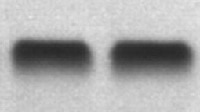Mouse Fas Ligand/TNFSF6 Antibody Summary
Pro132-Leu279
Accession # P41047
Applications
Mouse Fas Ligand/TNFSF6 Sandwich Immunoassay
Please Note: Optimal dilutions should be determined by each laboratory for each application. General Protocols are available in the Technical Information section on our website.
Scientific Data
 View Larger
View Larger
Cytotoxicity Induced by Fas Ligand/TNFSF6 and Neutralization by Mouse Fas Ligand/TNFSF6 Antibody. In the presence of a cross-linking antibody, Mouse polyHisti-dine Monoclonal Antibody (10 µg/mL, Catalog # MAB050), Recom-binant Mouse Fas Ligand/ TNFSF6 (Catalog # 526-SA) induces cytotoxicity in the Jurkat human acute T cell leukemia cell line in a dose-dependent manner (orange line). Under these conditions, cytotoxicity elicited by Recombinant Mouse Fas Ligand/ TNFSF6 (5 µg/mL) is neutral-ized (green line) by increasing concentrations of Rat Anti-Mouse Fas Ligand/TNFSF6 Monoclonal Antibody (Catalog # MAB5262). The ND50 is typically 5-20 µg/mL.
Reconstitution Calculator
Preparation and Storage
- 12 months from date of receipt, -20 to -70 °C as supplied.
- 1 month, 2 to 8 °C under sterile conditions after reconstitution.
- 6 months, -20 to -70 °C under sterile conditions after reconstitution.
Background: Fas Ligand/TNFSF6
Fas Ligand (FasL) is a 40 kDa type II membrane protein belonging to the TNF family. In the new TNF super family nomenclature, FasL is referred to as TNFSF6. The specific receptor for FasL is Fas (CD95, Apo-1), a 45 kDa type I transmembrane protein that is a member of the TNF receptor family. FasL is predominantly expressed on activated T cells and NK cells, while Fas is expressed on various types of cells. The Fas/FasL system plays a crucial role in modulating immune response by inducing cell apoptosis to maintain homeostasis, self-tolerance of lymphocytes, and immune privilege. FasL was reported to be a potent chemoattractant for neutrophils, suggesting a novel proinflammatory function of this molecule. Like other members of the TNF family, the membrane-bound FasL can be cleaved by metalloproteinase to generate the soluble Fas ligand (sFasL) which is mainly a non-covalently linked homotrimer. It has been shown that the membrane-bound TNF‑ alpha and FasL are primary activators of their receptors. In contrast to soluble TNF‑ alpha which has potent cytotoxicity, sFasL is much less cytotoxic. Studies have shown that sFasL may competitively inhibit the killing effect of membrane FasL indicating that the cleaving of membrane FasL might be a mechanism to down‑regulate their activities.
- Suda, T. et al. (1993) Cell 75:1169.
- Kägi, D. et al. (1994) Science 265:528.
- Schneider, P. et al. (1998) J. Exp. Med. 187:1205.
- Seino, K. et al. (1998) J. Immunol. 161:4484.
Product Datasheets
Citations for Mouse Fas Ligand/TNFSF6 Antibody
R&D Systems personnel manually curate a database that contains references using R&D Systems products. The data collected includes not only links to publications in PubMed, but also provides information about sample types, species, and experimental conditions.
7
Citations: Showing 1 - 7
Filter your results:
Filter by:
-
Adenovirus-Mediated FasL Minigene Transfer Endows Transduced Cells with Killer Potential
Authors: Madalina Dumitrescu, Violeta Georgeta Trusca, Lorand Savu, Ioana Georgeta Stancu, Attila Cristian Ratiu, Maya Simionescu et al.
International Journal of Molecular Sciences
-
FasL Modulates Expression of Mmp2 in Osteoblasts
Authors: E Svandova, B Vesela, H Lesot, J Sadoine, A Poliard, E Matalova
Front Physiol, 2018-09-19;9(0):1314.
Species: Mouse
Sample Types: Whole Cells
Applications: Inhibition -
Glycolysis promotes caspase-3 activation in lipid rafts in T cells
Authors: MA Secinaro, KA Fortner, O Dienz, A Logan, MP Murphy, V Anathy, JE Boyson, RC Budd
Cell Death Dis, 2018-01-19;9(2):62.
Species: Mouse
Sample Types: Cell Lysates
Applications: Western Blot -
The molecular signature of murine T cell homeostatic proliferation reveals both inflammatory and immune inhibition patterns
Authors: Karen A. Fortner, Jeffrey P. Bond, James W. Austin, Jeremy M. Boss, Ralph C. Budd
Journal of Autoimmunity
-
Response patterns of cytokines/chemokines in two murine strains after irradiation.
Authors: Zhang M, Yin L, Zhang K, Sun W, Yang S, Zhang B, Salzman P, Wang W, Liu C, Vidyasagar S, Zhang L, Ju S, Okunieff P, Zhang L
Cytokine, 2012-01-25;58(2):169-77.
Species: Mouse
Sample Types: Plasma
Applications: Luminex Development -
Antigen-specific CD25- Foxp3- IFN-gamma(high) CD4+ T cells restrain the development of experimental allergic encephalomyelitis by suppressing Th17.
Authors: Wildbaum G, Zohar Y, Karin N
Am. J. Pathol., 2010-04-09;176(6):2764-75.
Species: Mouse
Sample Types: In Vivo, Whole Cells
Applications: Neutralization -
Estrogen protects bone by inducing Fas ligand in osteoblasts to regulate osteoclast survival.
Authors: Krum SA, Miranda-Carboni GA, Hauschka PV, Carroll JS, Lane TF, Freedman LP, Brown M
EMBO J., 2008-01-24;27(3):535-45.
Species: Mouse
Sample Types: Whole Cells, Whole Tissue
Applications: IHC-P, Neutralization
FAQs
No product specific FAQs exist for this product, however you may
View all Antibody FAQsReviews for Mouse Fas Ligand/TNFSF6 Antibody
Average Rating: 5 (Based on 1 Review)
Have you used Mouse Fas Ligand/TNFSF6 Antibody?
Submit a review and receive an Amazon gift card.
$25/€18/£15/$25CAN/¥75 Yuan/¥2500 Yen for a review with an image
$10/€7/£6/$10 CAD/¥70 Yuan/¥1110 Yen for a review without an image
Filter by:






